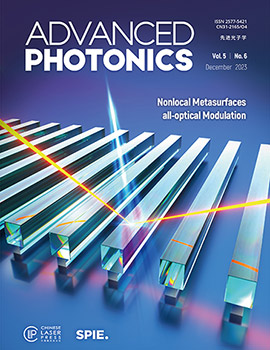Silicon-based optoelectronics for general-purpose matrix computation: a review
IF 18.8
1区 物理与天体物理
Q1 OPTICS
引用次数: 10
Abstract
Abstract. Conventional electronic processors, which are the mainstream and almost invincible hardware for computation, are approaching their limits in both computational power and energy efficiency, especially in large-scale matrix computation. By combining electronic, photonic, and optoelectronic devices and circuits together, silicon-based optoelectronic matrix computation has been demonstrating great capabilities and feasibilities. Matrix computation is one of the few general-purpose computations that have the potential to exceed the computation performance of digital logic circuits in energy efficiency, computational power, and latency. Moreover, electronic processors also suffer from the tremendous energy consumption of the digital transceiver circuits during high-capacity data interconnections. We review the recent progress in photonic matrix computation, including matrix-vector multiplication, convolution, and multiply–accumulate operations in artificial neural networks, quantum information processing, combinatorial optimization, and compressed sensing, with particular attention paid to energy consumption. We also summarize the advantages of silicon-based optoelectronic matrix computation in data interconnections and photonic-electronic integration over conventional optical computing processors. Looking toward the future of silicon-based optoelectronic matrix computations, we believe that silicon-based optoelectronics is a promising and comprehensive platform for disruptively improving general-purpose matrix computation performance in the post-Moore’s law era.用于通用矩阵计算的硅基光电子:综述
摘要传统的电子处理器是主流的、几乎不可战胜的计算硬件,在计算能力和能源效率方面都接近极限,尤其是在大规模矩阵计算中。通过将电子、光子和光电子器件和电路结合在一起,基于硅的光电子矩阵计算已经证明了强大的能力和可行性。矩阵计算是为数不多的在能效、计算能力和延迟方面有可能超过数字逻辑电路计算性能的通用计算之一。此外,在高容量数据互连期间,电子处理器还遭受数字收发器电路的巨大能量消耗。我们回顾了光子矩阵计算的最新进展,包括人工神经网络、量子信息处理、组合优化和压缩传感中的矩阵向量乘法、卷积和乘法-累加运算,特别关注能量消耗。我们还总结了基于硅的光电矩阵计算在数据互连和光子电子集成方面相对于传统光学计算处理器的优势。展望硅基光电子矩阵计算的未来,我们相信硅基光电子是一个很有前途的综合平台,可以在后摩尔定律时代颠覆性地提高通用矩阵计算性能。
本文章由计算机程序翻译,如有差异,请以英文原文为准。
求助全文
约1分钟内获得全文
求助全文
来源期刊

Advanced Photonics
OPTICS-
CiteScore
22.70
自引率
1.20%
发文量
49
审稿时长
18 weeks
期刊介绍:
Advanced Photonics is a highly selective, open-access, international journal that publishes innovative research in all areas of optics and photonics, including fundamental and applied research. The journal publishes top-quality original papers, letters, and review articles, reflecting significant advances and breakthroughs in theoretical and experimental research and novel applications with considerable potential.
The journal seeks high-quality, high-impact articles across the entire spectrum of optics, photonics, and related fields with specific emphasis on the following acceptance criteria:
-New concepts in terms of fundamental research with great impact and significance
-State-of-the-art technologies in terms of novel methods for important applications
-Reviews of recent major advances and discoveries and state-of-the-art benchmarking.
The journal also publishes news and commentaries highlighting scientific and technological discoveries, breakthroughs, and achievements in optics, photonics, and related fields.
 求助内容:
求助内容: 应助结果提醒方式:
应助结果提醒方式:


